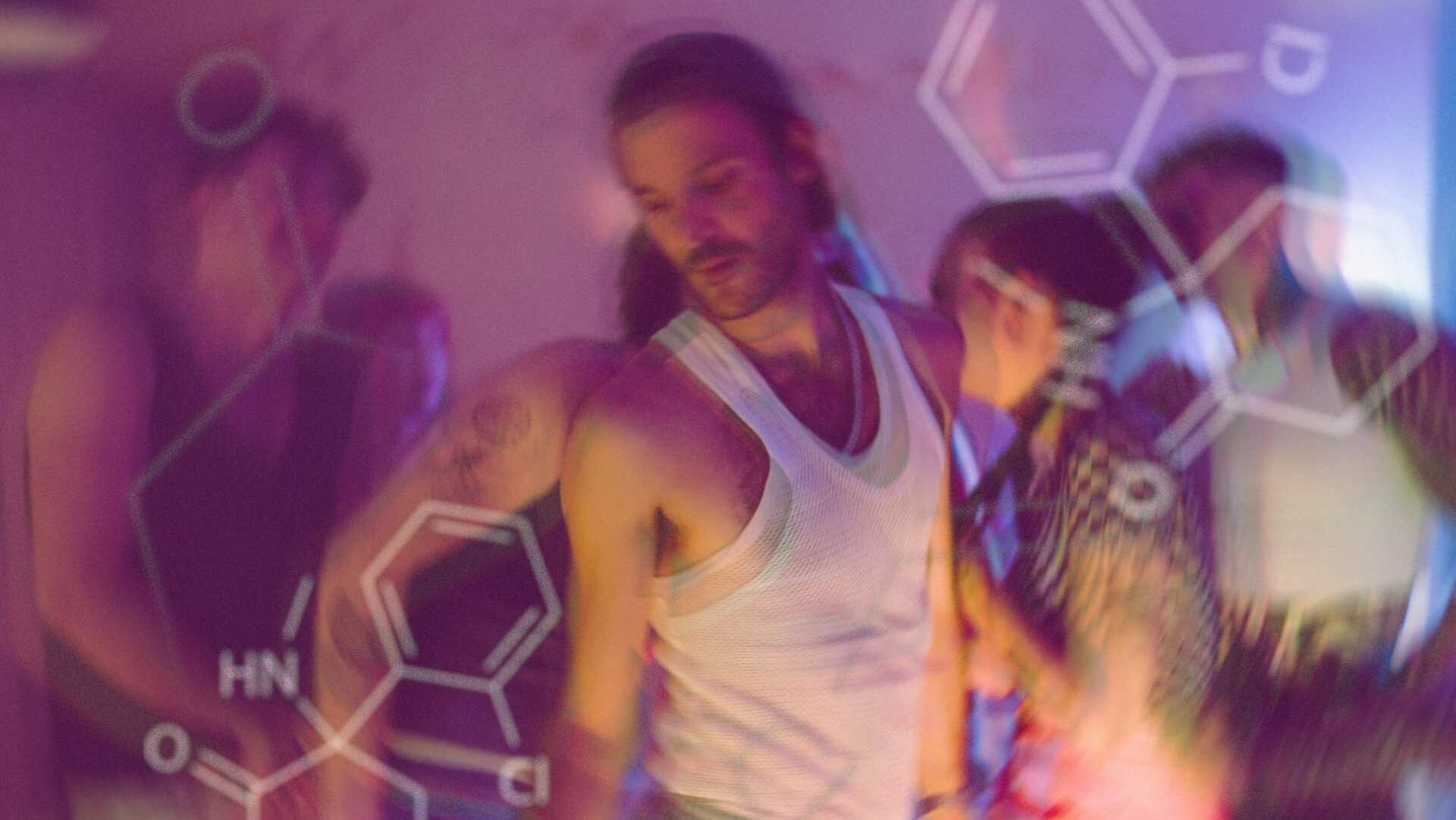Ketamine: What you need to know
Drag Race star The Vivienne's sister Chanel on why she's campaigning to spotlight how ketamine - widely considered a ‘safe’ party drug - can cause serious physical damage and psychological dependence

The new year had only just begun when news broke about the sudden and unexpected death of The Vivienne. The announcement in March by their family that The Vivienne, real name James Lee Williams, died from a cardiac arrest caused by ketamine left many in shock. It is often perceived by users as a ‘safe’ recreational drug, but The Vivienne’s passing put a spotlight on how ketamine abuse can lead to addiction and death, just like most other drugs — both legal and illegal.
Here, Attitude meets The Vivienne’s sister Chanel Williams to discuss the legacy that her family want the Drag Race UK winner to be remembered by. We also speak to David, who was a prominent DJ on the London gay scene in the 2000s before he developed a severe ketamine addiction and became the first known UK case of ketamine bladder syndrome. They both agree that education, awareness and openness is key to stopping misuse, addiction and needless deaths.
What is ketamine?
In medical use, ketamine is a dissociative general anaesthetic which is often used by doctors and vets because it produces pain relief and amnesia. It is considered a safer alternative to general anaesthetic for some people (e.g. older people and children) as it does not slow down a person’s breathing or heart rate.
Ketamine is also used as a party drug and is commonly referred to as ‘K’, ‘Ket’, or ‘Vitamin K’. In the short term, ketamine can induce feelings of euphoria and wellbeing, hallucinations and a sense of floating. But it can also cause drowsiness, amnesia, slurred speech, nausea, vomiting, and dissociation (a feeling of detachment from one’s body and the external world), due to it reducing or blocking signals to the conscious mind from other parts of the brain, such as the senses — sight, sound, taste, touch and smell.
Why is ketamine use on the rise?
Recent government figures estimate ketamine use in England and Wales has more than doubled since 2016, and more than tripled in the under-25 age group over the same period.
“[People think] these drugs aren’t really going to get you into a lot of trouble because you are just chilling out with them” – Liam, 31
Liam, a 31-year-old from London who used ketamine recreationally during his university years in the mid-2010s, believes there are “several reasons” for ketamine’s popularity with young people. “It is indeed easy to get hold of and affordable at around £20 per gram, but there are other significant factors as well,” he says. He puts part of its popularity down to how it makes you feel, in that people use it to relax and think it is low risk. “I think because it doesn’t give you that buzz, the adrenaline, the serotonin, the stimulation, it’s more of a stagnant response, like mushrooms or weed, [people think] these drugs aren’t really going to get you into a lot of trouble because you are just chilling out with them.”
Besides recreational purposes, drugs are also used as an escape from emotional distress, which typically explains why those in the queer community broadly use drugs at double the rate of the general population. Liam thinks ketamine’s numbing qualities also make it popular with those suffering from poor mental health. “I think some people also take it simply to escape their reality, as it numbs everything, which can be addictive,” he says.
Indeed, in an interview with The Guardian in September 2024, Owen Bowden-Jones, a consultant psychiatrist and founder of London drug addiction and rehab centre the Club Drug Clinic, cited poor mental health as an explanation for the increase in ketamine use. “My sense is the vast majority are using it to self-medicate for emotional distress. That would suggest to me they found a pharmacological short cut to managing their mental health.”
Interviewed by @guardian today abt rise in #ketamine use & harms. Important to consider underlying trauma which is often driving ketamine use. Urgent need for better trauma therapy & closer working between drug & mental health @ClubDrugClinic @CNWLNHS https://t.co/j0CoMLbk0x
— Owen Bowden-Jones (@OwenBowdenJones) September 16, 2024
In recent years, medical-grade ketamine has been used in controlled, clinical settings to help with treatment-resistant depression and other conditions. In some trials, ketamine rapidly reduced depression symptoms and provided relief for several days — a much faster response compared to other treatments. These trials suggest ketamine has the potential to relieve feelings of sadness, helplessness and even thoughts of suicide. However, this applies to medically administered doses; ketamine purchased illegally and taken without clinical supervision is unlikely to produce similar results.
According to anti-drug advisory service Talk to Frank, regular use of ketamine can in fact cause depression and even make existing mental health problems worse.
How dangerous is ketamine?
In a 2010 review by the Independent Scientific Committee on Drugs (ISCD), in which 20 of the most common legal and illegal drugs were ranked based on harm, ketamine ranked in 11th place, behind the likes of amphetamine, cocaine and opiates, as well as alcohol and tobacco. However, this comparison alongside its use in therapeutic settings might inadvertently have contributed to an underestimation of its potential dangers.
According to the National Programme on Substance Use Mortality (NPSUM), between 1997 and 2023, there were 389 deaths where ketamine was implicated as a cause. Of these, 55 took place in 2023 alone, representing 14 per cent of all recorded deaths. This is a steep increase compared to any previous year on record.
“While cardiac arrest from ketamine use is relatively rare, it can happen in certain circumstances”
Evidently, ketamine can indeed cause death, but it is still significantly less likely to do so when compared to class A drugs such as opiates and cocaine, which have also been associated with an increase in deaths.
While cardiac arrest from ketamine use is relatively rare, it can happen in certain circumstances. High doses of ketamine can lead to respiratory depression, which can strain the heart, and be particularly high risk for those with pre-existing heart issues.
Poly drug use also increases the risk. Using it in combination with other depressants, such as alcohol or opioids, can have a dangerous joint effect in slowing down the nervous system. Mixing ketamine with stimulants, like cocaine or MDMA, is also risky. Stimulants speed up the nervous system, while ketamine slows it down. This creates a conflicting effect on the body, putting immense stress on the heart and other organs.
Other physical effects of using ketamine include flashbacks, memory loss and poor concentration. Furthermore, heavy, regular use can result in liver damage, cause severe stomach pains, and inflict serious damage on the urinary tract. This is something which David experienced after years of heavy ketamine use.


In the 2000s, David was the resident DJ at Comptons bar in Soho, London. He started using ketamine recreationally as it was popular, cheap and easily available. “The first time I tried it, it was the most amazing experience, I’m not going to lie. The first few years were great, I experienced great visuals, and it was incredible. Then I just started using more and more, day to day,” explains David. “It became a habit, using the bullet and the sniffing — I used to do it at work all day, in the shop, whilst DJing. I could go through three to four bags a day, but then the pain started, and the pissing problems.
“My bladder was just scarring tissue, and the size of a tennis ball” – David Rogers
“It got to a point where I had to pee all the time. I finally went to see a urologist and ended up staying in the hospital for five days on an antibiotic drip. At first, they refused to believe it could be ketamine-related — the urologist had never seen scarring like that before,” says David. “My bladder was just scarring tissue, and the size of a tennis ball.”
It got to a point where David had to pee every hour and couldn’t drive a car or even walk due to the debilitating pain and constant need to urinate. But it didn’t stop him from continuing to use ketamine daily.
David never sought help for his ketamine addiction. He was honest about his daily usage, but in denial about it being a problem. He eventually quit his career and life in London and moved to Malta to break away from his habits and stop his daily ketamine use. It took six months before his bladder finally — and luckily for him — recovered.
“In ketamine bladder syndrome, the walls of the bladder become irritated and inflamed”
Back in the early 2000s, ketamine bladder syndrome was not well understood, and David ended up being the first officially known case in the UK. In ketamine bladder syndrome, the walls of the bladder become irritated and inflamed. It is not entirely clear why this happens, but the damage is believed to be due to the breakdown products of ketamine leaving the body via the bladder. If left untreated, the bladder tissue can eventually become scarred and the damage permanent, requiring major surgery and, in some cases, complete removal of the bladder.
Today, bladder issues are a well-known side effect from prolonged ketamine use, leading to frequent urination, infections, bleeding, blockages and incontinence.
Is ketamine addictive?
One misguided perception of ketamine is that it is not addictive because it has dissociative effects, similar to magic mushrooms and cannabis. Dissociative drugs primarily affect NMDA receptors in the brain, altering perception and creating a sense of detachment from reality. While this can produce a ‘high’, it doesn’t directly stimulate the brain’s reward system (dopamine pathways) as intensely as drugs like cocaine or heroin, which are highly addictive.
“Regular users can experience symptoms of ketamine withdrawal once they stop using it, including depression, excessive sleepiness and drug cravings”
However, ketamine can still cause addiction, especially if someone uses it to escape reality or cope with emotional pain. The Vivienne was open about their struggles with ketamine addiction. Regular users can experience symptoms of ketamine withdrawal once they stop using it, including depression, excessive sleepiness and drug cravings.
Would reclassification make a difference?
When a drug-related high-profile death such as The Vivienne’s occurs, the media is often quick to gravitate towards headline-friendly single solutions to ‘fix the problem’, which historically has often been to call for the drug in question to be reclassified. But when this has happened, did reclassification make any difference to overall usage, addiction and death rates? The answer is a resounding no.
“In 2009, cannabis was reclassified as a class B drug — but the move did not have the expected effect”
In 2008, then-Home Secretary Jacqui Smith requested that cannabis be reclassified as a Class B drug because of increasing concerns about a link between high-strength cannabis and schizophrenia. The Advisory Council on the Misuse of Drugs (ACMD) spoke out against the proposal, arguing that cannabis should remain a Class C drug because it is less harmful than other Class B drugs, such as amphetamine. Nevertheless, in 2009, cannabis was reclassified as a class B drug — but the move did not have the expected effect. Jacqui Smith later admitted that her decision to upgrade cannabis to a Class B drug was wrong, and that education would have been a better option than criminalisation.
It has been a similar story with GHB. Following a string of spiking incidents involving GHB in straight clubs, and in the aftermath of the case of the Grindr killer, Stephen Port, who used GHB to murder four young gay men and sexually assault several others, then-Home Secretary Priti Patel commissioned the ACMD to review the harms of GHB and make recommendations on how to address the issue. The ACMD made eight recommendations to the government, including mandatory testing and increased awareness and education. In the end, only one of the eight recommendations was actioned: the reclassification of GHB from a Class C to a Class B drug.
There is currently no evidence to suggest that this reclassification made any difference to prevalence of use, addiction or deaths. On the contrary, in a recent ITV news report, A&E doctors in London and the Metropolitan Police sounded the alarm that the harms from GHB and crystal meth (aka ‘chemsex drugs’) are at an all-time high.
Although the reclassification of a drug comes with more severe punishment for both those who sell and buy the drug, there is little evidence to suggest that it makes any material difference to the numbers of people using it. A drug being illegal likely deters many people from using it in the first place, but which specific illegal class it’s categorised within is unknown to most users, and likely not of concern.
How do we prevent ketamine addiction and deaths?
On 17th March, The Vivienne’s family made the brave choice to publicly share the cause of the star’s death. The Vivienne was without a doubt the biggest British drag queen to come out of RuPaul’s Drag Race, having been crowned the winner of the first UK season and subsequently gone on to win the hearts of the nation as the first drag queen to not only take part in Dancing on Ice, but also making it to the final, ultimately ending in third place. The Vivienne’s trajectory to stardom was as impressive as it was well deserved, making the sudden and unexpected end to their life heartbreaking. That they died from a cardiac arrest caused by ketamine was a further shock to many, despite The Vivienne being open about their past struggles with ketamine addiction.


“The first time we as a family ever knew that there had ever been any real issue for my brother with drugs, and specifically ketamine, was when he appeared on Drag Race,” says Chanel, The Vivienne’s older sister. Chanel and the family are now working with leading Welsh drug and alcohol addiction charity Adferiad to raise awareness about the dangers of ketamine.
Chanel continues, “It was really difficult for us to know that they’d been through that really difficult period of their life to the point that they’d been hospitalised three or four times.” This was because they were suffering from severe cramps caused by ketamine use. Despite being a close and loving family, James had never spoken to them about their addiction struggles before. Chanel thinks it’s because of the stigma around drug-taking and addiction, something she and her family are now actively campaigning to address.
Chanel believes her brother’s brave and honest approach to sharing their story of working through their ketamine addiction might in some ways have been a double-edged sword. Being open about former struggles can be cathartic, but when you are in the public eye, it might also come with added pressure to uphold the image of the ‘recovered drug addict’. It is possible that the pressure to maintain that image prevented them from reaching out for support when the conditions that encouraged the drug addiction in the past re-emerged, which may have been from external pressure, internal stress or, perhaps most likely, a combination of both.

Stigma, shame and denial are recurrent themes when speaking to people that have been or are struggling with drug addiction. Possibly in both James’ and David’s cases, a sense of wanting to deal with their struggles themselves, and a belief that family and friends would only add more stress to the situation if they knew, might prevent many from confiding in loved ones. In such circumstances, the anonymous support that professional services can provide is crucial.
Chanel and the family are supporting the Adferiad campaign ‘Only Human’ as ambassadors in a bid to challenge stigma and encourage more open conversations about addiction. Alongside campaigning to break the stigma around drug addiction, Chanel is also planning to raise awareness and provide education about the dangers of ketamine at schools around the country. “We’ve just allowed it to become more and more of an issue,” she says of how ketamine has become a more socially acceptable recreational drug. “Some of the things that I’ve read around children taking this drug… it’s really, really scary. You know, I’ve got two young girls, and I think it frightens me of what the future looks like if we don’t address this now.”
Signs of ketamine addiction
It can be hard to admit to having a ketamine addiction, or that you are just using it too often. If you find yourself using it in larger amounts and more frequently than intended, it might be a cause for concern. If you start neglecting responsibilities and relationships, and experience severe mood swings when not using, it’s advisable to reach out for help.
There are several national charities that can provide support. For general drug and addiction support, you can contact Adferiad. Specific drug addiction support for the LGBTQ+ community include Antidote (based in London) and Controlling Chemsex. Finally, if you have lost a loved one to a sudden and premature death, from drugs or suicide, You Are Loved provides free LGBTQ+ bereavement peer-support groups.
This feature was lifted from Issue 364 of Attitude magazine which is available to order here, and alongside 15 years of back issues on the free Attitude app.
